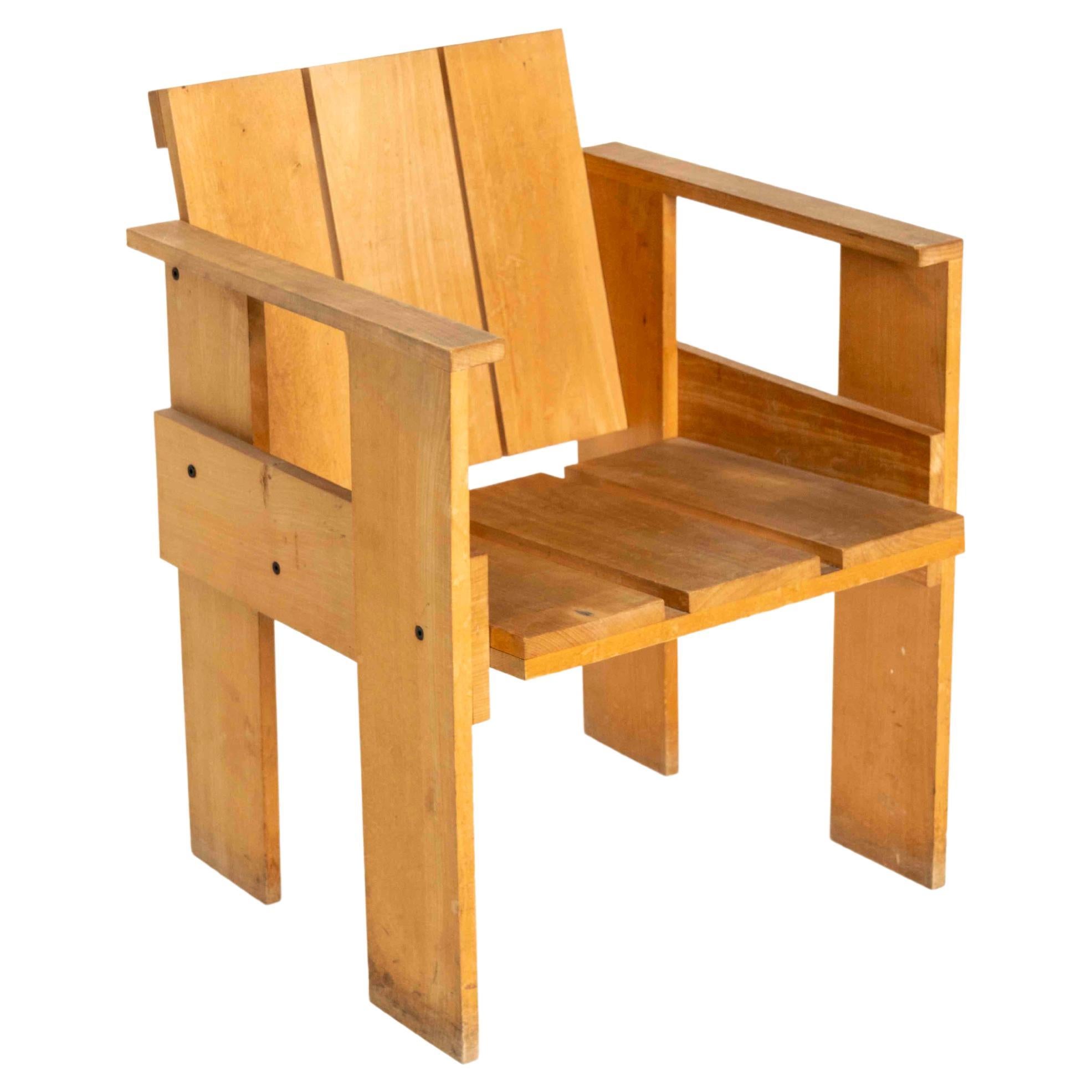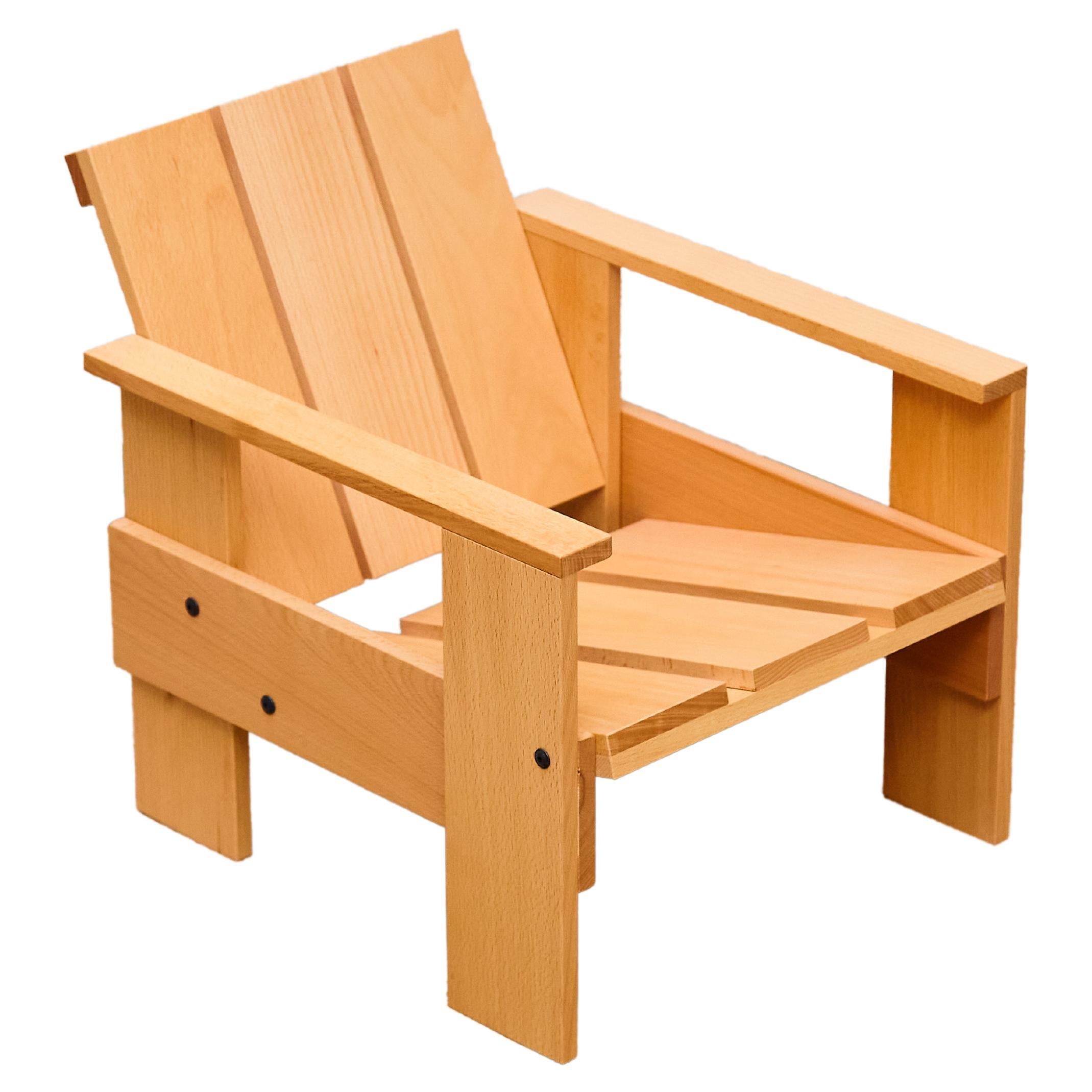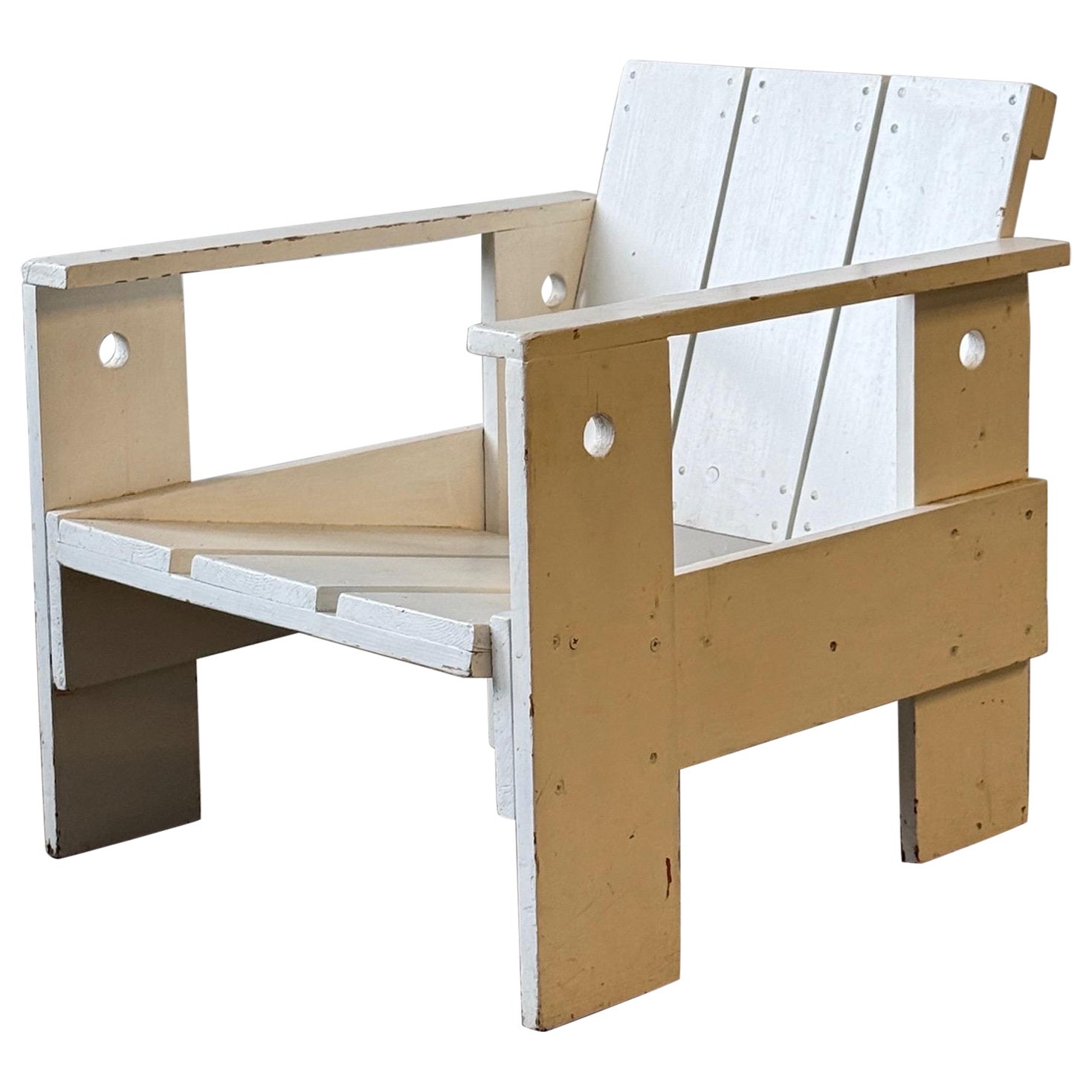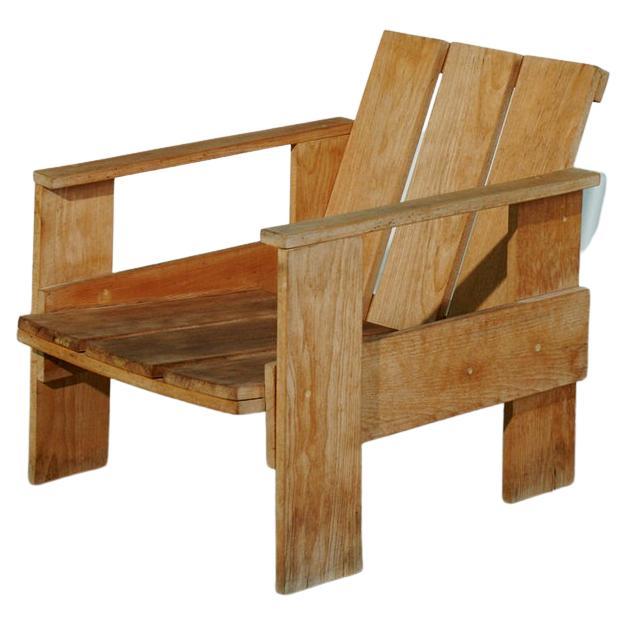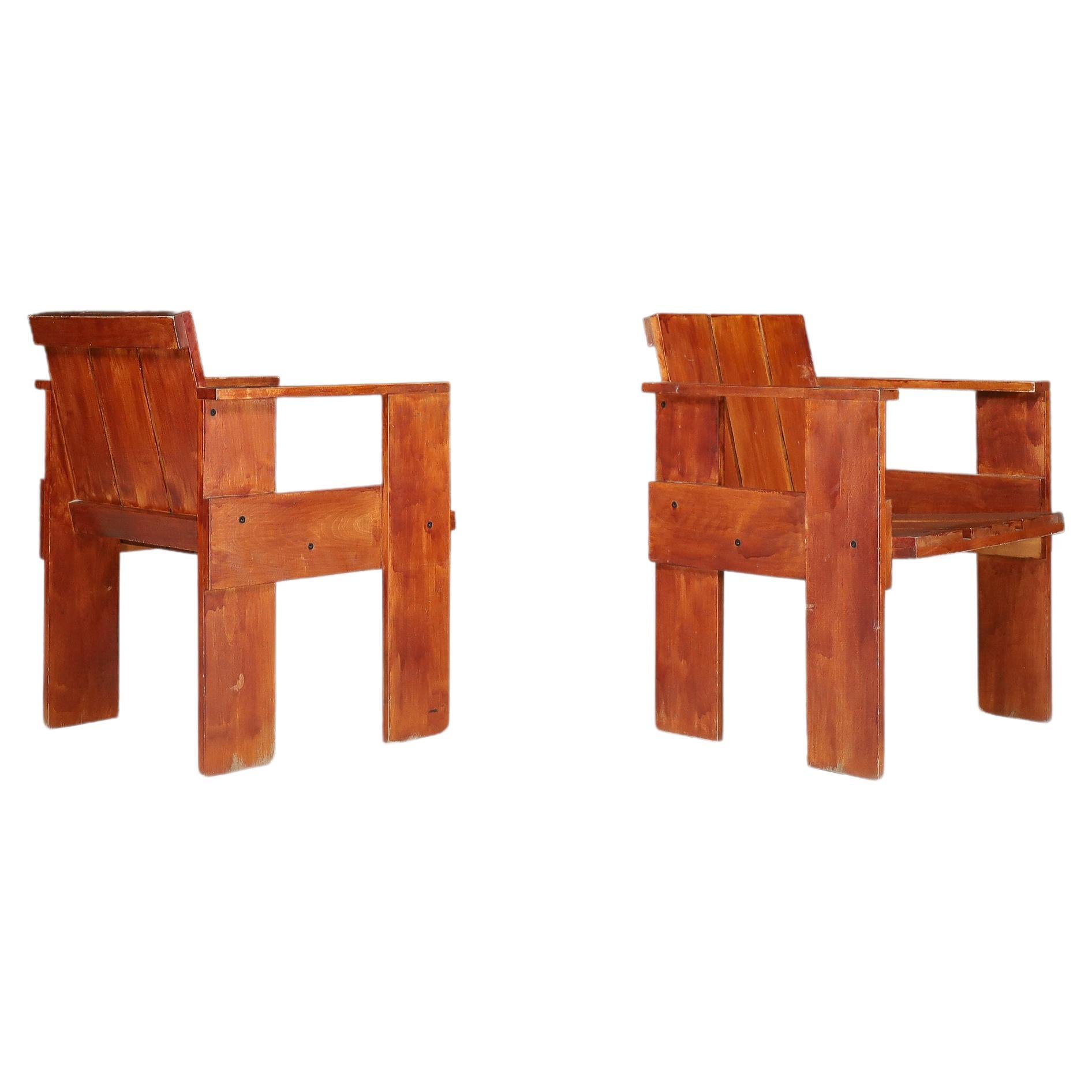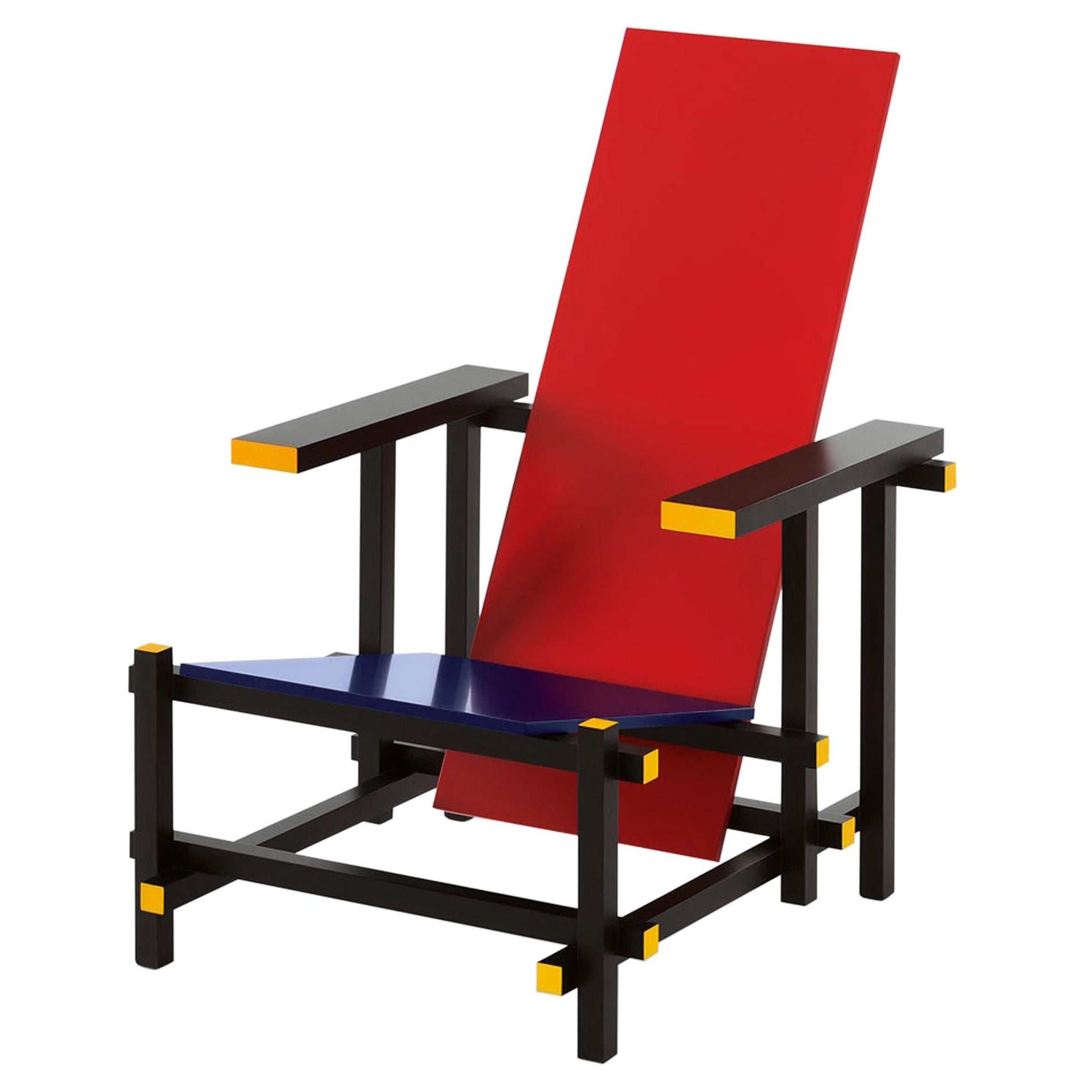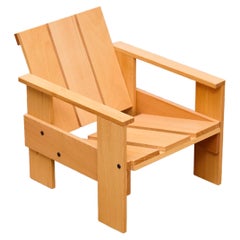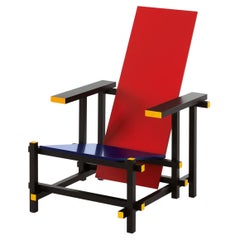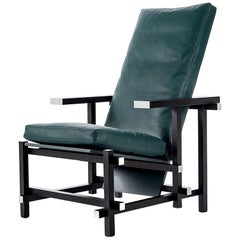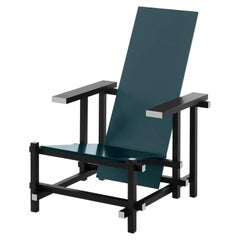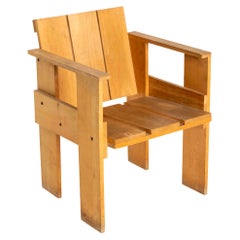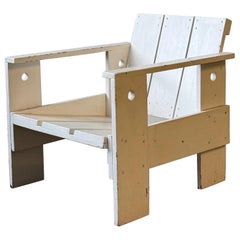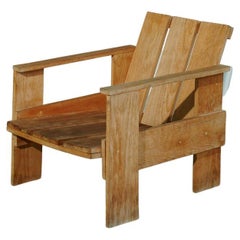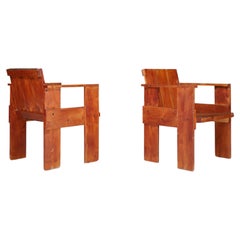Items Similar to Gerrit Rietveld Mid-Century Modern Wood Crate Chair, circa 1950
Want more images or videos?
Request additional images or videos from the seller
1 of 20
Gerrit Rietveld Mid-Century Modern Wood Crate Chair, circa 1950
About the Item
Crate chair designed by Gerrit Thomas Rietveld, executed circa 1950 by Metz and Co in Holland.
In good original condition, preserving a beautiful patina.
Materials
wood
Dimensions:
D 72.5 cm x W 57.9 cm x H 59 cm.
Gerrit Thomas Rietveld (24 June 1888–25 June 1964) was a Dutch furniture designer and architect. One of the principal members of the Dutch artistic movement called De Stijl, Rietveld is famous for his red and blue chair and for the Rietveld Schro¨der House, which is a UNESCO World Heritage site.
In 1934 Rietveld designed a first series of crate furniture, consisting of an armchair, a small bookcase and a small table. These were items for which the appearance was largely dictated by the application of standard lumber size planks for different parts of the furniture. The choice of using standardized Industrial products was motivated by Rietveld’s aim to make furniture production more efficient. The furniture is almost completely built from firewood planks with a width of, circa 15 cm. A constantly recurring, distinctive wide chink is left between the planks. Dry joints connect the components with brass screws, which are left visible. At this time this type of wood and construction method was used for packing crates, hence the name of the series.
The radically simple crate furniture was heavily criticized by some contemporaries, because of the lack of traditional workmanship. Rietveld defended his designs by saying that traditionally produced furniture was transported in crates to avoid being damaged. It was obvious to him that the packing material was stronger, and therefore better, than its content. After 1935 much more crate furniture followed, including various chairs, tables and stools. After producing them in his own name for a while, the crate furniture was sold by Metz and Co. under the name ‘weekend furniture.’ Because of the simple appearance and the relatively low price they were most suitable for holiday homes.
Important literature: Gerrit Rietveld, IDA va Zijl, Phaidon 2010.
Gerrit Th. Rietveld 1888-1964, Marijke Ku¨per IDA van Zijl, Centraal Museum 1992.
The complete Rietveld furniture, Peter Vo¨ge, 010 publischers Rotterdam 1993.
- Attributed to:Gerrit Rietveld (Designer)
- Dimensions:Height: 23.63 in (60 cm)Width: 22.84 in (58 cm)Depth: 28.55 in (72.5 cm)
- Style:Mid-Century Modern (In the Style Of)
- Materials and Techniques:
- Place of Origin:
- Period:
- Date of Manufacture:circa 1950
- Condition:Wear consistent with age and use.
- Seller Location:Barcelona, ES
- Reference Number:Seller: RT.14.02.23.GB.6071stDibs: LU1427232758332
About the Seller
4.9
Platinum Seller
Premium sellers with a 4.7+ rating and 24-hour response times
Established in 2015
1stDibs seller since 2015
1,827 sales on 1stDibs
Typical response time: 5 hours
- ShippingRetrieving quote...Shipping from: Barcelona, Spain
- Return Policy
Authenticity Guarantee
In the unlikely event there’s an issue with an item’s authenticity, contact us within 1 year for a full refund. DetailsMoney-Back Guarantee
If your item is not as described, is damaged in transit, or does not arrive, contact us within 7 days for a full refund. Details24-Hour Cancellation
You have a 24-hour grace period in which to reconsider your purchase, with no questions asked.Vetted Professional Sellers
Our world-class sellers must adhere to strict standards for service and quality, maintaining the integrity of our listings.Price-Match Guarantee
If you find that a seller listed the same item for a lower price elsewhere, we’ll match it.Trusted Global Delivery
Our best-in-class carrier network provides specialized shipping options worldwide, including custom delivery.More From This Seller
View AllGerrit Rietveld Wood Child Armchair 'Crate' by Rietveld by Rietveld, circa 2005
By Gerrit Rietveld
Located in Barcelona, Barcelona
Low drawer chair in natural wood with lacquer for Children by Gerrit Rietveld. Produced by Rietveld family including individual number and chip. Beautiful and fun design. This chair ...
Category
Early 2000s Dutch Mid-Century Modern Armchairs
Materials
Wood
£1,129 Sale Price
25% Off
Gerrit Rietveld Red and Blue Chair by Cassina
By Cassina, Gerrit Rietveld
Located in Barcelona, Barcelona
Chair designed by Gerrit Rietveld in 1918. Relaunched in 1973.
Manufactured by Cassina in Italy.
A sculptural seat with a pure and rationalist form, this chair became an authenti...
Category
2010s Italian Mid-Century Modern Armchairs
Materials
Wood
£4,933 / item
Gerrit Rietveld Zeilmaker Version of Black Red and Blue Chair by Cassina
By Cassina, Gerrit Rietveld
Located in Barcelona, Barcelona
Chair designed by Gerrit Rietveld in 1920. Relaunched in 2015.
Manufactured by Cassina in Italy.
One of the versions of the iconic model dated 1918. The structure is in black-stained beechwood with white contrasting parts. Seat and back in green lacquered multiplywood. The armchair can have a single seat and backrest cushion in fabric or leather.
The black red and blue (Zeilmaker version) born from Rietveld’s chromatic experimentation
While researching the origins of the red and blue model in collaboration with the Rietveld heirs, it emerged that the key idea of the first prototypes was based on the concept of spatial organization expressed through the monochrome tones of its elements. The first version was in fact produced in 1918 in completely unpainted wood.
In the following years Rietveld proposed various examples, either monochrome or painted in different colors, depending on the requirements of his customers and the interiors for which the chairs were intended. As such, it comes as no surprise to find this 1920s version, presented as part of Cassina’s MutAzioni selection, created for the school teacher Wicher Zeilmaker with a black frame with white ends and a dark green painted seat and backrest.
It was Rietveld’s ever-increasing involvement in the De Stijl movement that led him to also use primary colors on this model in 1923, and as such the chair became a veritable manifesto for the emerging neoplastic movement. Initially dubbed slat chair, Rietveld only gave it the name red and blue in the 1950s following its chromatic evolution.
The various owners of the different examples used the chair as an abstract-realist sculpture in their interiors and, in some cases, as a simple tool for sitting on, adding cushions to make it more comfortable, just like Cassina offers for the black red and blue today.
Important information regarding images of products:
Please note that some of the images show other colors and variations of the model, these images are only to present interior design proposals. The item that is selling is on the first image.
Important information regarding color(s) of products:
Actual colors may vary. This is due to the fact that every computer monitor, laptop, tablet and phone screen has a different capability to display colors and that everyone sees these colors differently. We try to edit our photos to show all of our products as life-like as possible, but please understand the actual color may vary slightly from your monitor
About the designer:
Gerrit Thomas Rietveld, born in Utrecht on 24 June 1888, seems possessed of two personalities, each so distinct that one might take his work to be that of more than one artist. The first personality is that seen in the craftsman cabinet-maker working in a primordial idiom, re-inventing chairs and other furniture as if no one had ever built them before him and following a structural code all of his own; the second is that of the architect working with elegant formulas, determined to drive home the rationalist and neoplastic message in the context of European architecture. The two activities alternate, overlap, and fuse in a perfect osmosis unfolding then into a logical sequence. In 1918 Rietveld joined the “De Stijl” movement which had sprung up around the review of that name founded the year before by Theo van Doesburg. The group assimilated and translated into ideology certain laws on the dynamic breakdown of compositions (carrying them to an extreme) that had already been expressed in painting by the cubists: the “De Stijl” artists also carefully studied the architectonic lesson taught by the great Frank Lloyd Wright, whose influence was widely felt in Europe at that time.
Collaborating first with Robert van’t Hoff and Vilmos Huszar...
Category
2010s Italian Mid-Century Modern Armchairs
Materials
Leather, Wood
Gerrit Rietveld Zeilmaker Version of Black Red and Blue Chair by Cassina
By Gerrit Rietveld, Cassina
Located in Barcelona, Barcelona
Chair designed by Gerrit Rietveld in 1920. Relaunched in 2015.
Manufactured by Cassina in Italy.
One of the versions of the iconic model dated 1918. The structure is in black-stained beechwood with white contrasting parts. Seat and back in green lacquered multiplywood.
The black red and blue (Zeilmaker version) born from Rietveld’s chromatic experimentation
While researching the origins of the red and blue model in collaboration with the Rietveld heirs, it emerged that the key idea of the first prototypes was based on the concept of spatial organization expressed through the monochrome tones of its elements. The first version was in fact produced in 1918 in completely unpainted wood.
In the following years Rietveld proposed various examples, either monochrome or painted in different colors, depending on the requirements of his customers and the interiors for which the chairs were intended. As such, it comes as no surprise to find this 1920s version, presented as part of Cassina’s MutAzioni selection, created for the school teacher Wicher Zeilmaker with a black frame with white ends and a dark green painted seat and backrest.
It was Rietveld’s ever-increasing involvement in the De Stijl movement that led him to also use primary colors on this model in 1923, and as such the chair became a veritable manifesto for the emerging neoplastic movement. Initially dubbed slat chair, Rietveld only gave it the name red and blue in the 1950s following its chromatic evolution.
The various owners of the different examples used the chair as an abstract-realist sculpture in their interiors and, in some cases, as a simple tool for sitting on, adding cushions to make it more comfortable, just like Cassina offers for the black red and blue today.
Important information regarding images of products:
Please note that some of the images show other colors and variations of the model, these images are only to present interior design proposals. The item that is selling is on the first image.
Important information regarding color(s) of products:
Actual colors may vary. This is due to the fact that every computer monitor, laptop, tablet and phone screen has a different capability to display colors and that everyone sees these colors differently. We try to edit our photos to show all of our products as life-like as possible, but please understand the actual color may vary slightly from your monitor
About the designer:
Gerrit Thomas Rietveld, born in Utrecht on 24 June 1888, seems possessed of two personalities, each so distinct that one might take his work to be that of more than one artist. The first personality is that seen in the craftsman cabinet...
Category
2010s Italian Mid-Century Modern Armchairs
Materials
Leather, Wood
£4,320 Sale Price / item
22% Off
Gerrit Rietveld Zeilmaker Version of Black Red and Blue Chair by Cassina
By Cassina, Gerrit Rietveld
Located in Barcelona, Barcelona
Chair designed by Gerrit Rietveld in 1920. Relaunched in 2015.
Manufactured by Cassina in Italy.
One of the versions of the iconic model dated 1918. The structure is in black-stained beechwood with white contrasting parts. Seat and back in green lacquered multiplywood. The armchair can have a single seat and backrest cushion in fabric or leather.
The black red and blue (Zeilmaker version) born from Rietveld’s chromatic experimentation
While researching the origins of the red and blue model in collaboration with the Rietveld heirs, it emerged that the key idea of the first prototypes was based on the concept of spatial organization expressed through the monochrome tones of its elements. The first version was in fact produced in 1918 in completely unpainted wood.
In the following years Rietveld proposed various examples, either monochrome or painted in different colors, depending on the requirements of his customers and the interiors for which the chairs were intended. As such, it comes as no surprise to find this 1920s version, presented as part of Cassina’s MutAzioni selection, created for the school teacher Wicher Zeilmaker with a black frame with white ends and a dark green painted seat and backrest.
It was Rietveld’s ever-increasing involvement in the De Stijl movement that led him to also use primary colors on this model in 1923, and as such the chair became a veritable manifesto for the emerging neoplastic movement. Initially dubbed slat chair, Rietveld only gave it the name red and blue in the 1950s following its chromatic evolution.
The various owners of the different examples used the chair as an abstract-realist sculpture in their interiors and, in some cases, as a simple tool for sitting on, adding cushions to make it more comfortable, just like Cassina offers for the black red and blue today.
Production delay:
8-9 weeks
Important information regarding images of products:
Please note that some of the images show other colors and variations of the model, these images are only to present interior design proposals. The item that is selling is on the first image.
Important information regarding color(s) of products:
Actual colors may vary. This is due to the fact that every computer monitor, laptop, tablet and phone screen has a different capability to display colors and that everyone sees these colors differently. We try to edit our photos to show all of our products as life-like as possible, but please understand the actual color may vary slightly from your monitor
About the designer:
Gerrit Thomas Rietveld, born in Utrecht on 24 June 1888, seems possessed of two personalities, each so distinct that one might take his work to be that of more than one artist. The first personality is that seen in the craftsman cabinet-maker working in a primordial idiom, re-inventing chairs and other furniture as if no one had ever built them before him and following a structural code all of his own; the second is that of the architect working with elegant formulas, determined to drive home the rationalist and neoplastic message in the context of European architecture. The two activities alternate, overlap, and fuse in a perfect osmosis unfolding then into a logical sequence. In 1918 Rietveld joined the “De Stijl” movement which had sprung up around the review of that name founded the year before by Theo van Doesburg. The group assimilated and translated into ideology certain laws on the dynamic breakdown of compositions (carrying them to an extreme) that had already been expressed in painting by the cubists: the “De Stijl” artists also carefully studied the architectonic lesson taught by the great Frank Lloyd Wright, whose influence was widely felt in Europe at that time.
Collaborating first with Robert van’t Hoff and Vilmos Huszar, then with Theo van Doesburg and Cornelius van Eesteren, Rietveld soon became one of the most distinguished interpreters of the neoplastic message.
Among his most important works are:
the Schröder house at Utrecht (1924); the “Row Houses” at Utrecht (1931-1934); the Dutch pavilion at the Venice Biennial (1954); the sculpture pavilion in the Rijksmuseum Kröller-Müller at Otterloo and the Van Gogh Museum in Amsterdam (1955). Out of his equally important furniture, Cassina has chosen for its own production: the “Red and Blue” (1918), the “Zig-Zag” (1934), the “Schröder 1...
Category
2010s Italian Mid-Century Modern Armchairs
Materials
Leather, Wood
£4,843 Sale Price / item
25% Off
Gerrit Rietveld Zeilmaker Version of Black Red and Blue Chair by Cassina
By Cassina, Gerrit Rietveld
Located in Barcelona, Barcelona
Chair designed by Gerrit Rietveld in 1920. Relaunched in 2015.
Manufactured by Cassina in Italy.
One of the versions of the iconic model dated 1918. The structure is in black-stained beechwood with white contrasting parts. Seat and back in green lacquered multiplywood.
The black red and blue (Zeilmaker version) born from Rietveld’s chromatic experimentation
While researching the origins of the red and blue model in collaboration with the Rietveld heirs, it emerged that the key idea of the first prototypes was based on the concept of spatial organization expressed through the monochrome tones of its elements. The first version was in fact produced in 1918 in completely unpainted wood.
In the following years Rietveld proposed various examples, either monochrome or painted in different colors, depending on the requirements of his customers and the interiors for which the chairs were intended. As such, it comes as no surprise to find this 1920s version, presented as part of Cassina’s MutAzioni selection, created for the school teacher Wicher Zeilmaker with a black frame with white ends and a dark green painted seat and backrest.
It was Rietveld’s ever-increasing involvement in the De Stijl movement that led him to also use primary colors on this model in 1923, and as such the chair became a veritable manifesto for the emerging neoplastic movement. Initially dubbed slat chair, Rietveld only gave it the name red and blue in the 1950s following its chromatic evolution.
The various owners of the different examples used the chair as an abstract-realist sculpture in their interiors and, in some cases, as a simple tool for sitting on, adding cushions to make it more comfortable, just like Cassina offers for the black red and blue today.
Important information regarding images of products:
Please note that some of the images show other colors and variations of the model, these images are only to present interior design proposals. The item that is selling is on the first image.
Important information regarding color(s) of products:
Actual colors may vary. This is due to the fact that every computer monitor, laptop, tablet and phone screen has a different capability to display colors and that everyone sees these colors differently. We try to edit our photos to show all of our products as life-like as possible, but please understand the actual color may vary slightly from your monitor
About the designer:
Gerrit Thomas Rietveld, born in Utrecht on 24 June 1888, seems possessed of two personalities, each so distinct that one might take his work to be that of more than one artist. The first personality is that seen in the craftsman cabinet-maker working in a primordial idiom, re-inventing chairs and other furniture as if no one had ever built them before him and following a structural code all of his own; the second is that of the architect working with elegant formulas, determined to drive home the rationalist and neoplastic message in the context of European architecture. The two activities alternate, overlap, and fuse in a perfect osmosis unfolding then into a logical sequence. In 1918 Rietveld joined the “De Stijl” movement which had sprung up around the review of that name founded the year before by Theo van Doesburg. The group assimilated and translated into ideology certain laws on the dynamic breakdown of compositions (carrying them to an extreme) that had already been expressed in painting by the cubists: the “De Stijl” artists also carefully studied the architectonic lesson taught by the great Frank Lloyd Wright, whose influence was widely felt in Europe at that time.
Collaborating first with Robert van’t Hoff and Vilmos Huszar, then with Theo van Doesburg and Cornelius van Eesteren, Rietveld soon became one of the most distinguished interpreters of the neoplastic message.
Among his most important works are:
the Schröder house at Utrecht (1924); the “Row Houses” at Utrecht (1931-1934); the Dutch pavilion at the Venice Biennial (1954); the sculpture pavilion in the Rijksmuseum Kröller-Müller at Otterloo and the Van Gogh Museum in Amsterdam (1955). Out of his equally important furniture, Cassina has chosen for its own production: the “Red and Blue” (1918), the “Zig-Zag” (1934), the “Schröder 1...
Category
2010s Italian Mid-Century Modern Armchairs
Materials
Leather, Wood
£4,320 Sale Price / item
22% Off
You May Also Like
Crate Chair by Gerrit Rietveld, Designed in 1930s The Netherlands
By Cassina, Gerrit Rietveld
Located in Hellouw, NL
Nice Gerrit Rietveld 'Crate' chair. This chair is designed in 1934, however, we think this is a Cassina edition from the 1970s. This chair is made out of ash wood and has a colorless lacquer.
'Gerrit Rietveld designed the 'crate' series of furniture built from standardized pine boards – cheap material for packing crates – which were soon well-known as ‘crate furniture’. 'From 1935 on the progressive designs appeared at Metz & Co, where furniture by Rietveld had already been sold since 1930. The crate desk...
Category
Vintage 1930s Dutch Mid-Century Modern Armchairs
Materials
Pine
Early Crate Chair by Gerrit Rietveld
By Gerrit Rietveld
Located in Chicago, IL
c. Early/Mid 20th Century. Painted wood crate chair with excellent patina.
Category
Mid-20th Century Dutch Mid-Century Modern Chairs
Materials
Wood
‘Crate’ Chair in Wood, Attributed to Gerrit Rietveld
By Gerrit Rietveld
Located in Berlin, BE
‘Crate’ chair in wood, Attributed to Gerrit Rietveld
Additional information:
Material: Wood
Designer: Gerrit Rietveld
Size: 61 W x 54 D x 70 H cm.
Category
Vintage 1980s Chairs
Materials
Wood
Gerrit Rietveld for Cassina Crate Chairs, Italy, 1970s
By Gerrit Rietveld, Cassina
Located in Almelo, NL
Gerrit Rietveld for Cassina crate chairs, Italy 1970s.
Pair of two Gerrit Rietveld' Crate' chairs. These chairs were designed in 1934 and produced by...
Category
Vintage 1970s Italian Modern Armchairs
Materials
Ash
4 MODERNIST BRUTALIST "CRATE" CHAIRS by GERRIT RIETVELD, Holland 1980
By Gerrit Rietveld
Located in PARIS, FR
A suite of 4 "Crate" chairs, Constructivist, Cubist, Modernist, Brutalist, geometric structures in blackened solid wood, based on the model by Gerrit Rietveld, handcrafted by anonymo...
Category
Vintage 1970s French Modern Chairs
Materials
Wood
Crate Chair in style of Gerrit Rietveld, The Netherlands 1960's
By Gerrit Rietveld
Located in Den Haag, NL
Crate Chair in style of Gerrit Rietveld, The Netherlands 1960's. In solid Pinewood with lovely patina and wear.
Category
Vintage 1960s Dutch Mid-Century Modern Armchairs
Materials
Pine
Recently Viewed
View AllMore Ways To Browse
15th Century Dutch Furniture
15 Th Century Furniture
Chairs 15 Th Century
Wavy Metal Side Table
Wedgwood Bird
Wegner Ch23
Wegner Ge 375
Weird Ring
White Ceramic Garden Stool
White Gold Dinnerware
White Lacquer Bar Cart
Widdicomb Brass Coffee Tables
Widdicomb Round Table
Wikkelso Capella
Willy Guhl Chair Concrete
Willy Rizzo Tortoiseshell
Windsor Rocking Chairs
Wine Glass Cristal
